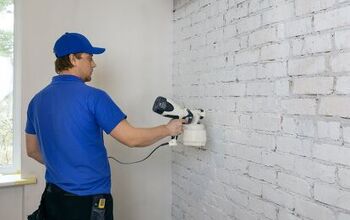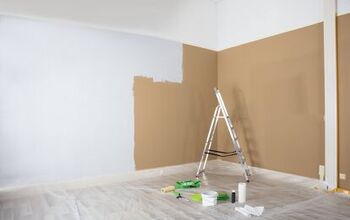Can You Put Polyurethane Over Paint? (Find Out Now!)

Polyurethane comes in handy for many reasons. But it’s not ideal for all projects. So, can you put polyurethane over paint, or do you have to use something else? Keep reading to find out.
You can put polyurethane over paint to help protect the surface. Plus, a thin coat can help improve the look of your walls and furniture. However, you must prepare the surface first. Otherwise, polyurethane can ruin your paint.
Do You Need to Hire a Paint Contractor?
Get free, zero-commitment quotes from pro contractors near you.

How Long Should You Wait to Put Polyurethane Over Paint?
Although you can apply polyurethane after painting, wait for the surface to dry first. That’s because your topcoat can smear the paint underneath if it’s still tacky. So, most professional painters wait at least 24 hours between coats.
Make your final coat look even better by using a primer beneath your paint. Then, sand the surface to get rid of bumps once the paint dries. Do touch-ups at this stage. And finish with a generous coat of polyurethane to protect your hard work.
TIP: Reduce your wait time. Use a roller to eliminate dripping paint and brush strokes.
Do I Need Polyurethane After Painting?
You don’t always need polyurethane after painting. Many brands make their paints with primer or topcoats already in them. So, read the label first. And keep in mind that polyurethane can’t adhere to some materials.
How Do You Apply Polyurethane Over Paint?
Applying poly over paint is easy. You don’t even need any particular skills or equipment. Just grab a high-quality synthetic paintbrush to get the job done. Then, wait for your paint to dry before getting started.
Put polyurethane or polyacrylic over paint using long strokes to prevent smudging and caking. For the best look, apply more than one coat. But don’t forget to wait between coats because you could smear the layer underneath. Expect at least two to three hours with most brands.
TIP: You can test the surface with a gentle touch to find out if the last layer is dry or not.
How Long Does Polyurethane Take to Harden?
When your last layer is dry to the touch, you can move on to the next step. That’s called the “dry time,” which varies with each project. But the “cure time” is different. That’s how long it takes your polyurethane to harden. And it may take longer than you think.
You might assume that dry polyurethane is automatically hard, but it’s not. Most of the time, polyurethane reaches maximum hardness after 20-30 days. Before that, you can damage the surface because you didn’t let it cure long enough. But always check the label for specific instructions.
How Do You Prep Polyurethane for Painting?
Start your project with a good oil-based primer. That way, you begin painting with an already prepped surface. Primers can also help stains adhere to the material. So, apply an even coat of primer underneath the paint, and then wait overnight for it to dry.
After that, paint the surface. Apply as many layers as needed, but don’t forget to sand in between them. And when the paint dries, apply polyurethane one layer at a time.
What’s the Best Polyurethane to Use Over Paint?
Water-based polyurethanes are best for bright or dark paint colors. Plus, you should use water-based varieties on materials such as plastic and metal. But you can switch to oil-based polyurethane and achieve similar results. Oily formulas are also better for painted wood because they soak into the grains and protect the surface better.
NOTE: Oil-based polyurethane creates a yellow tint on the surface. So, you can’t use it over white paint.
Will Polyurethane Stick to Oil-Based Paint?
You can use an all oil-based arsenal to complete your painting project. Just be sure you sand and clean the surfaces before beginning. That way, the topcoat will adhere better to the paint underneath it.
Most oily paints spread quickly and hide imperfections without a topcoat. But oily polyurethane helps level the surface even more, resulting in a much smoother finish. So, choose a combination to create the finish you desire.
Related Questions
How Do I Get a Smooth Polyurethane Finish?
To get a super smooth finish when applying polyurethane after painting, use 240-grit sandpaper between each coat. That way, you don’t destroy the stain underneath, but you still buff out the imperfections.
Which Is Better: Polycrylic or Polyurethane?
There’s a difference between polyacrylic and polyurethane. For one, polyurethane is usually oil-based and durable. People use it to refinish wood furniture and floors. But polyacrylic is typically water-based. So, it’s less durable in many cases. However, the water-based formula is less toxic and odorous than oil-based polyurethane.
Are Four Coats of Polyurethane Too Much?
Try to cover painted surfaces with at least three thin coats of polyurethane. Four coats may be too much, depending on the type of material you’re using. Either way, don’t apply thick coats because they could make your surface look uneven. Thin coats help level each layer, and they’re easier to sand in between. So, wait for each coat to dry and judge as you go.
What Happens If You Don’t Sand in Between Coats of Polyurethane?
If you don’t sand in between coats of polyurethane, your surface could look and feel rough. Your topcoat cannot hide every bump or imperfection on its own. You have to buff the surface before moving on to the next step, or your project quality will suffer.
Do You Need to Hire a Paint Contractor?
Get free, zero-commitment quotes from pro contractors near you.

Paint and Poly Like a Pro
Whether you use oil-based or water-based polyurethane, always read the instructions. Find out if it’s compatible with your materials and paint first. Then, apply it in thin layers to achieve the look you desire. And don’t forget to sand in between, or else your finish won’t turn out as smooth as it could be.
Related Guides

Tiffany Nichols specializes in aesthetics, design, marketing, and manufacturing. She's a copywriter and editor for several home renovation companies in the U.S. and works alongside some of the biggest names in the industry. Her hobbies include architecture, art, mental health, and fashion.
More by Tiffany Nichols



























